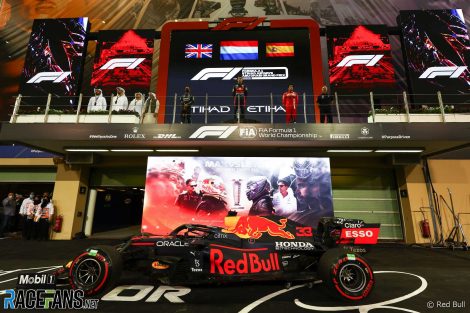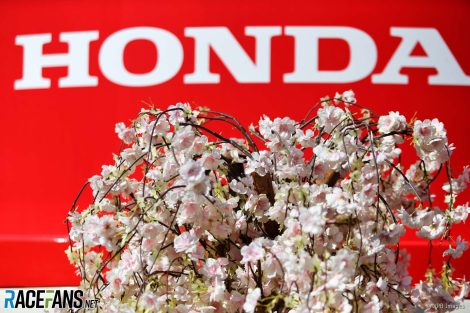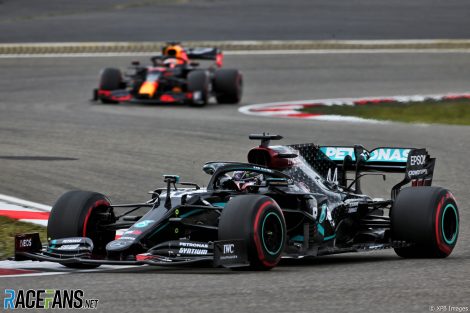[ad_1]
The information of Honda’s newest return to Method 1 was thought-about essential sufficient that a minimum of its world CEO Toshihiro Mibe appeared earlier than the media as we speak to announce it.
As he did, Mibe additionally referred to the corporate’s final deprature from F1. That was introduced lower than three years in the past and got here into impact on the finish of the 2021 season, simply 17 months previous.
Mibe harassed the choice to sever its ties with Purple Bull, who went on to take Max Verstappen to the 2021 championship utilizing Honda’s energy items, was a “tough” one for the corporate. It attracted appreciable debate and criticism, not least as Purple Bull went on to dominate the subsequent two seasons utilizing Honda-developed engines.
“In 2020, after we introduced our resolution to conclude our F1 participation, we acquired a wide range of harsh feedbacks from members of the media and our followers,” mentioned Mibe. “It was an agonising however essential resolution for Honda as a way to strengthen our initiatives towards the realisation of carbon neutrality.

“The choice has produced the specified impact inside our firm. Within the meantime, we want to sincerely thank racing followers whose pleasure and help to our F1 actions have at all times been an excellent motivation. We are going to try to answer their cheers and expectations greater than ever earlier than.”
Honda quickly reversed its resolution to surrender on F1. It has already begun work on an influence unit for the brand new 2026 rules which shall be utilized by Aston Martin.
However does Honda’s sudden U-turn show it made a mistake by leaving within the first place – and that the “harsh” criticism it confronted was warranted?
Advert | Become a RaceFans supporter and
It’s straightforward to criticise Honda’s departure in gentle of the success it went on to take pleasure in with Purple Bull. However most of that lay forward of it when it introduced its exit.

Beneath the V6 hybrid turbo rules, automobiles powered by Honda-developed engines have received 39 grands prix. However by October 2nd 2020, when Honda advised media it will pull out of F1 on the finish of the next season, it had simply 5 wins underneath the present guidelines.
Did the torrent of wins which adopted look prone to materialise at that time? Probably not. Honda’s most up-to-date triumph, Pierre Gasly’s victory within the Italian Grand Prix, was a considerably lucky win aided by a well timed crimson flag interruption. And it had solely taken one different victory that season.
However whereas Purple Bull-Honda didn’t look sure to displace Mercedes as F1’s main group, that they had clearly emerged because the closest menace, and that’s one thing the Japanese producer tossed away too frivolously.
Honda had returned to F1 with McLaren in 2015, reforming their powerhouse partnership of the Nineteen Eighties and Nineteen Nineties. However the reunion lasted three largely depressing seasons and resulted in a humiliating divorce.
One other blow to Honda’s delight got here when it agreed an engine provide cope with Sauber, solely to see the group cancel the plan following a change of administration. Ultimately, after a 12 months supplying engines to Toro Rosso (now AlphaTauri), Purple Bull grew to become satisfied of Honda’s potential.
Advert | Become a RaceFans supporter and
In 2019 the brand new alliance scored a breakthrough victory on the Red Bull Ring, the primary of three wins that season. When Ferrari endured a dire 2020 marketing campaign, Purple Bull-Honda emerged as Mercedes’ closest challenger.

Nevertheless it was nonetheless a distant menace. On the day Honda introduced it was performed with F1, Purple Bull had little greater than half of Mercedes’ factors whole that season.
Quickly after Honda confirmed its plans to depart, occasions swung in Purple Bull’s favour. An aerodynamic guidelines tweak for the 2021 season hit Mercedes particularly arduous, and all of a sudden Verstappen was within the thick of a championship battle with Lewis Hamilton. He prevailed – albeit underneath deeply contentious circumstances – leaving Honda within the weird place of celebrating a championship triumph whereas they headed for the exit.
After F1’s rules reset of 2022 it took just a few months for Purple Bull to search out their stride, having sunk a lot effort into the earlier 12 months’s marketing campaign it handed Ferrari a possibility to shut up. However Purple Bull had been quickly again on prime (arguably aided by their 2021 budget cap overspend, the penalty for which is still being meted out) and on the time of writing they’ve received 15 of the final 16 races.
No marvel Honda’s resolution to depart seems to be questionable looking back. Of their defence, it’s straightforward to neglect how a lot of Purple Bull’s success got here after the announcement of their departure.
Honda had sunk enormous sums into enhancing its F1 engine. In 2020 the pricey growth race was nonetheless happening, and the producer might anticipate that programme to eat extra funds which it needed to deploy elsewhere. Solely after Honda’s exit did F1 groups conform to freeze energy unit growth, which paradoxically made remaining within the collection extra engaging. Whereas the producer agreed to assist Purple Bull proceed operating the engines it had already developed by its Honda Racing Company identification, because the group grew to become F1’s dominant pressure the Honda stickers soon returned to the engine covers.
Advert | Become a RaceFans supporter and
Even taking all this into consideration, Honda’s 2020 resolution to depart nonetheless seems hasty looking back. They’d been working with Purple Bull for lower than two years and made appreciable strides in enhancing their competitiveness. 5 wins over two years was an enormous enchancment over what that they had performed as much as that time within the V6 hybrid turbo period, and begs the query how nice a achieve was wanted as a way to keep away from it leaving the game?
No producer has come and gone from F1 as readily as Honda. They’d a full works programme within the Nineteen Sixties, then returned as an engine producer within the Nineteen Eighties and ’90s and loved enormous success. After leaving and returning once more as an engine provider, Honda went down the total group route once more for what turned out to be simply three years earlier than it stop once more – this time abandoning a very aggressive automobile it had developed at enormous expense. That automobile went on to take a championship sweep utilizing Mercedes energy, laying the groundwork for that model to emerge as F1’s new energy.
As they put together to make their newest return, the query is whether or not Honda can’t solely produce a aggressive bundle, however rediscover the endurance which yielded its golden interval over 30 years in the past.
2023 F1 season
[ad_2]
Source link


